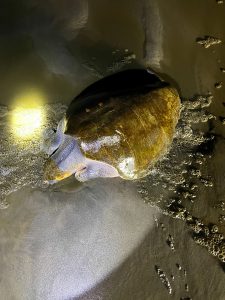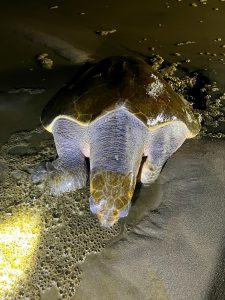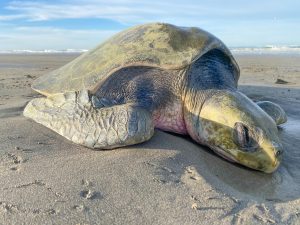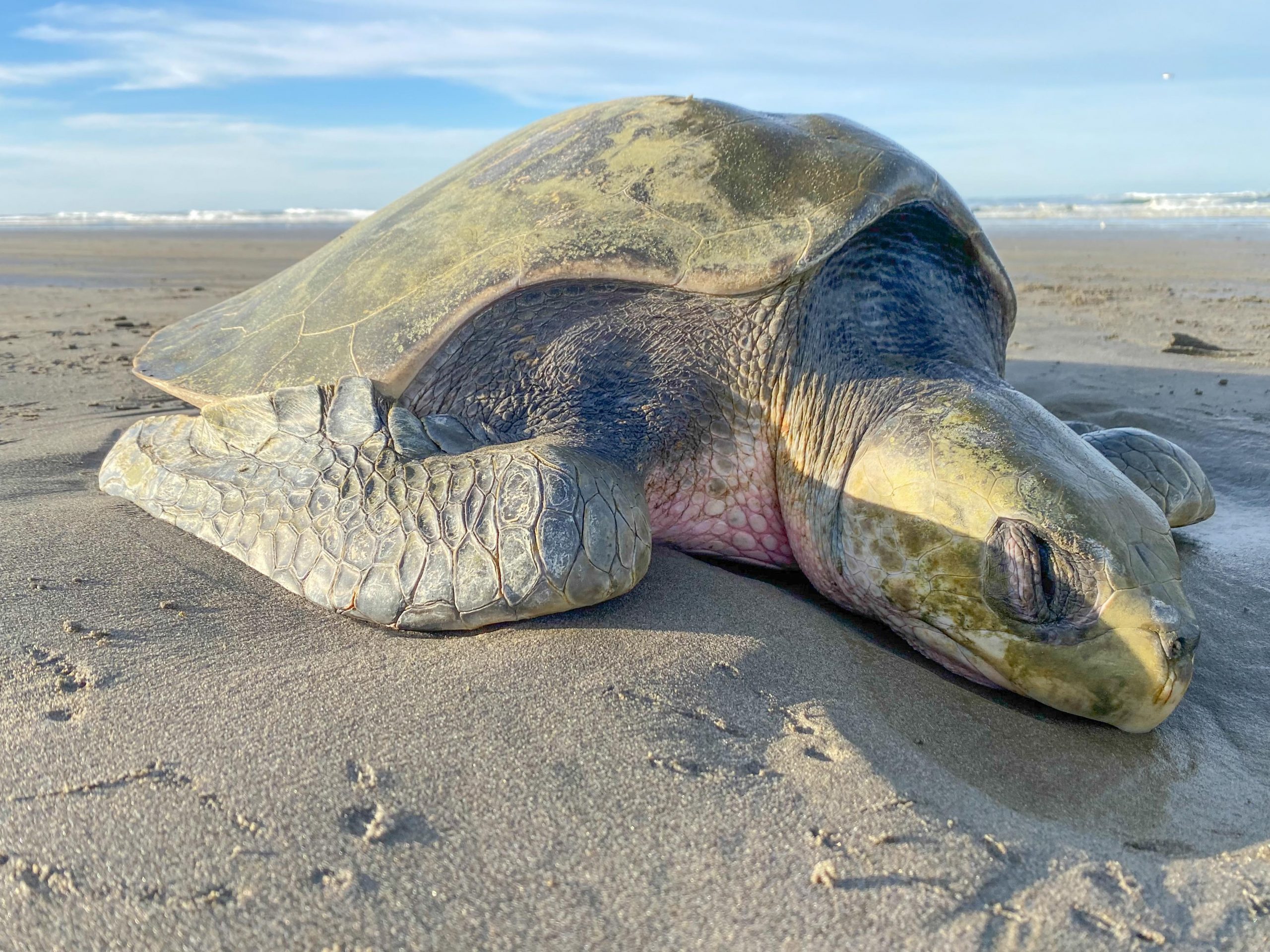By Tiffany Boothe, Seaside Aquarium
It all started on Tuesday, November 16th. A report came through to the Seaside Aquarium about a stranded turtle near Ocean Park, Washington. The aquarium crew quickly responded but by the time they arrived the turtle had vanished. It was assumed that someone came across the turtle on the beach, thought it was dead, and picked it up. An action that is highly illegal.
At 7:30 a.m. on Sunday morning, November 21st, the aquarium got another report of a stranded turtle but this time it was a bit further north in Oysterville, Washington. The aquarium asked if the reporting party would stay with the turtle until staff could get up there and retrieve the turtle. Luckily, they had the time and were thrilled to stay and “turtle sit”. When staff arrived, they were surprised to see that it was the same sea turtle that had been stranded nearly a week earlier. Distinctive marks on the turtle’s shell confirmed it was the same animal. When these cold-stunned sea turtles wind up on the beach it can be very difficult to determine if the animal is dead or alive. They can be unresponsive, and their heartbeat can slow to one beat per minute. Other than being highly illegal, it is important to never take a sea turtle off the beach. Though it might look dead, there is a chance it is still alive. In fact, when the aquarium responds to stranded sea turtles, they treat them all as if they are alive until proven otherwise and that is exactly how they treated this turtle. The fully grown, olive ridley sea turtle, was not showing any signs of life but it wasn’t until the turtle had been recovered and taken back to the Seaside Aquarium for observation that it was eventually declared dead.



While this situation is very sad, the aquarium would like to take the time to thank everyone involved in trying to rescue this animal. Thank you to the reporting party, Portland State University for helping to organize transfer of the turtle to a rehab facility, and the Oregon Coast Aquarium for being willing to take the turtle in for rehabilitation.
As far as we know this is the fourth turtle to be recovered in the last two months and “turtle season” has just begun. Two olive Ridley sea turtles stranded in Oregon October 27th, 2021 both were alive and taken to the Oregon Coast Aquarium and a green sea turtle stranded on the Washington Coast and is currently undergoing rehab at the Seattle Aquarium.
Cold-stunned sea turtles can be extremely difficult to rehab. Not only are they suffering from extreme hypothermia, but they also often have other underlying conditions such as pneumonia, infection, and dehydration. They are also prone to broken bones or damage to their shell due to stormy weather, heavy surf, or stranding on a rocky beach. It takes a great deal of care and dedication to work with these animals knowing only about 5% survive.
If you do happen to come across a sea turtle on either an Oregon or Washington beach contact the closest aquarium, state police, or the marine mammal stranding network. If possible, stay with the turtle until someone can respond. Do not move or touch the turtle unless advised to do so by a stranding official.

Here is a little background for Olive Ridley sea turtles and why they frequent the Oregon and Washington Coast:
Olive Ridley (Lepidochelys olivacea)
Here is a possible (and quite startling!) scenario that may unfold during a wintery beachcombing expedition on the Oregon Coast: While perusing the beach for treasures, you might suddenly come across something large that you don’t quite recognize. A rock, perhaps? Then it hits you; this “large rock” is actually a 50-pound sea turtle! Unbeknownst to most, during the winter, cold-shocked sea turtles can become stranded on our beaches. Reports of stranded turtles can begin as early as mid-October and can continue through January.
Essentially, sea turtles forage for food in an offshore, warm water current. Weather conditions (such as a long, constant string of south-southwesterly winds) can drive the warm water current (and therefore the turtles) further north and closer to shore than normal. When the weather conditions suddenly change, the warm waters quickly dissipate, and the turtles find themselves trapped in the colder waters of the natural currents running along the Oregon and Washington Coasts. When this happens, their bodies slow down, and they become hypothermic. Those that can make it to shore ‘haul’ out to get out of the cold water, but the winter conditions on the beach are rarely more hospitable.
When found on the beach, it can be difficult to determine if a sea turtle is dead or alive. A turtle suffering from extreme hypothermia can be unresponsive to touch and have a heartbeat so slow and weak that it is difficult to detect. Most sea turtles found on Oregon and Washington shores do not survive, even if found and recovered quickly. Those that do live are taken to one of two licensed rehab facilities on the Northwest Coast; the Oregon Coast Aquarium or the Seattle Aquarium. When stabilized (which, if successful, can take up to a few weeks), the turtle is transferred to a center in California, where it will be released back into the wild.
Though the Oregon Coast may see as many as five different species of sea turtle, the most commonly found is the Olive Ridley (Lepidochelys olivacea). This is partly due to the fact that, globally, they are the most abundant species of sea turtle (with an estimated population of 800,000 nesting females). Even with such seemingly “robust” numbers, these turtles are considered endangered and face many threats from the modern world. The expansion of the shrimp trawling fishery in the eastern Indian Ocean has had a major impact on the Oliver Ridley population, contributing to up to 10,000 deaths each year. Thankfully, in 2004 the Odisha government introduced an annual fishing ban from November to May (the time of year when the turtles are nesting) that has reduced their incidental mortality by half, and surveys found that nesting surged to record numbers in 2011.
Another major threat to the Olive Ridley population is their own biology. They are one of only two species of sea turtle to engage in synchronized mass-nesting (a behavior called Arribadas). This means that, almost simultaneously, thousands of female turtles will pull themselves out of the water and high up onto the beach, in the darkness of night to lay their eggs. With competition for space, females often dig up another female’s nest, unintentionally destroying the newly laid eggs in order to deposit her own eggs.
Olive Ridley sea turtles return to the same beach they were hatched on to lay their eggs. The largest rookery (nesting site) is located on Gahirmatha Beach in India with a nesting population between 100,000 to 500,000 individuals each year. Other nesting sites can be found in Costa Rica, Mexico, and Nicaragua.
After the crowded nesting season is over, the Ridleys return to their quiet, solitary life where they roam the oceans of the world, living in multiple different habitats and geographical localities.


